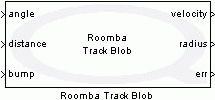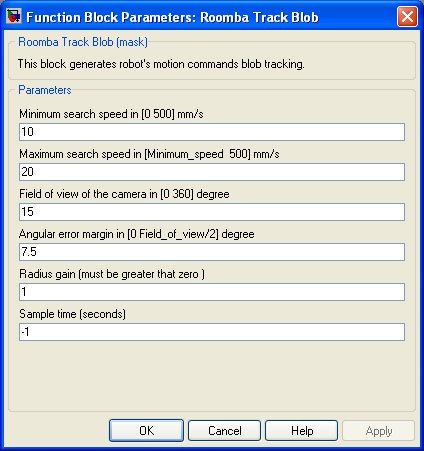

Roomba Track Blob
Generates motion commands (velocity and radius of curvature) to track a blob.
Library
QUARC Targets/Devices/Third-Party/iRobot/Roomba/Applications MATLAB Command Line Click to copy the following command line to the clipboard. Then paste it in the MATLAB Command Window: qc_open_library('quarc_library/Devices/Third-Party/iRobot/Roomba/Applications')
Description

The Roomba Track Blob block generates motion commands (velocity and radius of curvature) to track a blob in the current image frame of the camera. The blob is specified using its orientation with respect to the image center. The robot stops when it detects obstacles using range or bump sensor.
Input Ports
angle
Horizontal and vertical angular deviation of the blob (in degrees) with respect the image center (see Vision Get Centroid Pose block).
distance
Distance to obstacles obtained from range sensors. Use -1 if range sensors are not mounted on the robot.
bump
Bump sensor value returned by Roomba. Use Roomba Sensor Request or Roomba Query List block to get bump feedback.
Output Ports
velocity
Velocity of the robot to reach the target position. Use this output as the velocity input of Roomba Drive block.
radius
Radius of curvature of the robot's motion to reach the target. Use this output as the radius input of Roomba Drive block.
err
The signal returns negative value in case of memory allocation error.
Parameters and Dialog Box

Minimum search speed
Specifies the minimum velocity of the robot. The velocity must be 0 to 500 mm/s.
Maximum search speed
Specifies the maximum velocity of the robot. The velocity must be 0 to 500 mm/s and greater than the minimum velocity.
Fied of view of the camera
Specifies the field of view of the camera in degrees. The parameter value must be 0 to 360 degrees. Note that this value must be the same as specified in Vision Get Centroid Pose block. Lower values of this parameter result in less changes in the robot's motion direction.
Angular error margin
Specifies the angular error margin in degrees used for motion command generation. The robot maintains the same motion direction and velocity if the angular deviation between the robot's orientation and the specified blob is less than the error margin.
Radius gain
Specifies the radius gain which is used to control the radius curvature of the robot's motion. The parameter value must be greater than zero. Lower values of this parameter cause sharp changes in robot's motion direction.
Sample time
The sample time of the block. A sample time of 0 indicates that the block will be treated as a continuous time block. A positive sample time indicates that the block is a discrete time block with the given sample time. A sample time of -1 indicates that the block inherits its sample time.
Targets
|
Target Name |
Compatible* |
Model Referencing |
Comments |
|---|---|---|---|
|
Yes |
Yes |
||
|
Yes |
Yes |
||
|
Yes |
Yes |
||
|
Yes |
Yes |
||
|
Yes |
Yes |
||
|
Yes |
Yes |
||
|
Yes |
Yes |
||
|
Yes |
Yes |
||
|
Yes |
Yes |
||
|
Yes |
Yes |
||
|
Yes |
Yes |
||
|
Yes |
Yes |
||
|
Yes |
Yes |
||
|
Yes |
Yes |
Last fully supported in QUARC 2018. |
|
|
Rapid Simulation (RSIM) Target |
Yes |
Yes |
|
|
S-Function Target |
No |
N/A |
Old technology. Use model referencing instead. |
|
Normal simulation |
Yes |
Yes |
See Also

Copyright ©2025 Quanser Inc. This page was generated 2025-11-01. Submit feedback to Quanser about this page.
Link to this page.